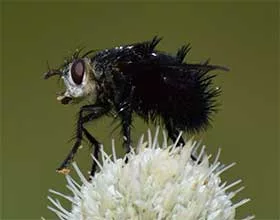 Of the million or so insect species that have been described so far, between 100 and 150 thousand are in the order Diptera—the flies. As the name Diptera indicates (“di” means “two,” and “ptera” means “wings”), flies share the characteristic of having just two wings for flight, unlike most insects, which have four. But while they do have that trait in common, there’s also a lot of diversity among the flies. The dipteran order is divided into more than 150 families, including well-known groups like the house flies (family Muscidae), fruit flies (Drosophilidae), hover flies (Syrphidae), and mosquitoes (Culicidae).
Of the million or so insect species that have been described so far, between 100 and 150 thousand are in the order Diptera—the flies. As the name Diptera indicates (“di” means “two,” and “ptera” means “wings”), flies share the characteristic of having just two wings for flight, unlike most insects, which have four. But while they do have that trait in common, there’s also a lot of diversity among the flies. The dipteran order is divided into more than 150 families, including well-known groups like the house flies (family Muscidae), fruit flies (Drosophilidae), hover flies (Syrphidae), and mosquitoes (Culicidae).
Bristle flies, family Tachinidae, might be less familiar than some of those other groups. However, they are one of the most diverse dipteran families, with about 10,000 species described so far, including more than 500 in Ohio. Tachinids play important roles in natural systems, and some species have even been imported as biological agents of pest control.
The name “bristle fly” implies that members of this group are spiky or hairy. That certainly is true for many species, impressively so for some. However, tachinids are quite variable in appearance. Among the species that are common locally are feather-legged flies (with bright orange abdomens, black wings that are held out to the sides, and feathery hind legs), Juriniopsis flies (covered front to back in spiky black bristles), and Gymnosoma flies (with bulging red eyes and smooth, round, patterned abdomens).
What all tachinid flies do share is a particular life cycle: they are parasitoids. What that means is that the juvenile form of the fly—the larva, or maggot—develops inside the body of a host, which ultimately dies as a result. Caterpillars of moths and butterflies are the most common hosts, but some tachinids parasitize other insects like beetles, wasps, or grasshoppers. The larva feeds on its host from the inside and ultimately kills it—not unlike the xenomorphs in Alien!
Female tachinids use a variety of strategies for getting their offspring into a host. Most often, tachinid eggs begin to develop while they are still inside the female fly, so they are ready to hatch shortly after laying. In some species, the fly uses the direct approach, injecting her eggs into a host. In other species, the eggs are attached onto the surface of the host; when the larvae emerge, they burrow inside. Yet another strategy is for the female fly to lay her eggs in sites where hosts are likely to encounter them, such as on leaves where the host feeds or by the host’s burrow in the soil. The fly larvae then either seek out the host or grab onto it when it happens by.
As the larva consumes its host, it matures and then metamorphoses into a pupa. That is often the life stage that overwinters, in which case the adults emerge the following year as temperatures warm. Adult tachinids mostly feed on nectar and pollen. Locally, they can be found visiting many species of wildflowers and, like bees and butterflies, are important pollinators.
Those two elements of their lifestyle—adults as pollinators, larvae as caterpillar killers—make tachinids welcome elements of human agriculture and gardening. It is thought that tachinids and other parasitoids (like some wasps) limit populations of caterpillars in the wild. Humans have tried to exploit that capability, using tachinids for non-chemical control of pests in forest and agricultural settings. More than 100 years ago, tachinids from Europe were brought to the U. S. to control gypsy moth caterpillars, which had been introduced previously from Europe and were defoliating northeastern forests. That effort, and repeated efforts since then to use tachinids to control stink bugs, various caterpillars, and other pests, have met with mixed success.
Unfortunately, as so often happens when people try to tinker with natural systems, tachinid introductions have had unintended side effects. In particular, most tachinids attack more than one host species, and so flies introduced for biocontrol of particular pests have ended up reducing populations of desirable native species as well. Moreover, it remains a challenge to generate large numbers of tachinids in laboratory settings for commercial purposes. Tachinids remain a part of the arsenal for crop management, but they do not seem to be a “magic bullet” for chemical-free pest control.
That being said, tachinid flies are interesting, cool-looking animals and are good for the garden. In a recent study of tachinid diversity in nearby Greene County, about 200 species were identified at a single site over the course of a couple of years. Both the number of individual flies and the diversity of species were greatest in early autumn. Tachinids like to feed on Queen Anne’s lace, goldenrod, and many other late-season wildflowers; now is the time to head out to look for them!
Article and photo contributed by Dr. David L. Goldstein, Emeritus Professor, Department of Biological Sciences, Wright State University.
